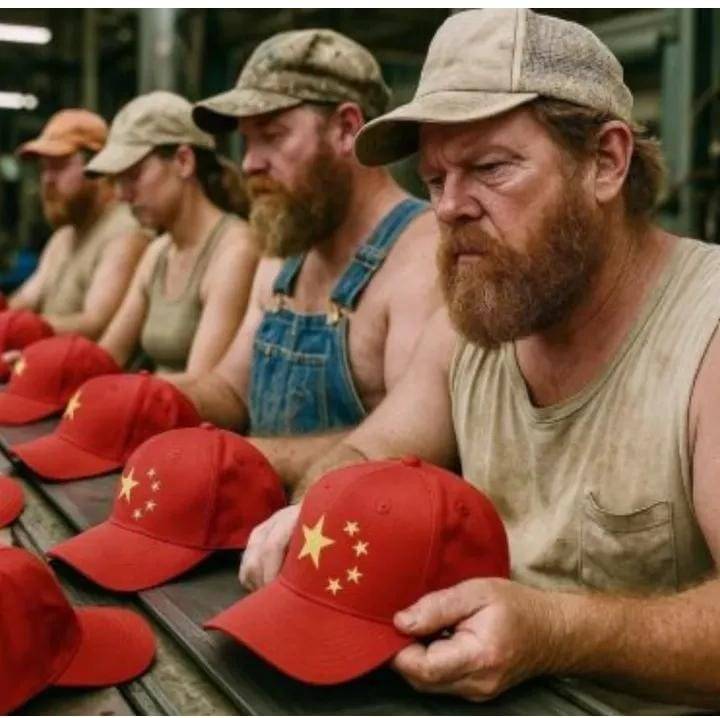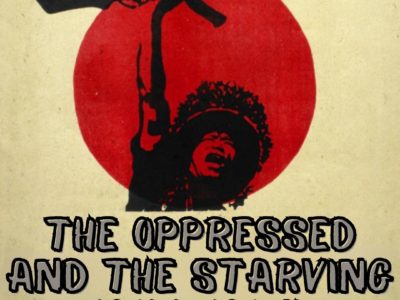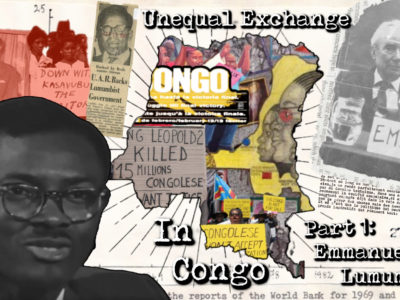The Trump administration’s tariff proposals, in addition to generating great financial and diplomatic instability over the past few days, have had a curious side effect. Not only within the left, but also within conservative circles, many have been forced to admit that the level of consumption of the American population depends, to a large extent, on the importation of cheap products. Or, to put it another way: that the current living conditions of the American population would be unthinkable without the existence of an enormous flow of cheap goods from the rest of the world.
Acknowledging this truism is usually a bad taste even among the ranks of the communist movement, accustomed to “absolving” the proletariat of the Western countries of any kind of participation in the fruits of imperialist plunder. However, the force of the facts – that is, the threat that Trump’s tariffs will jeopardize the relative well-being enjoyed today by large segments of the U.S. population – has set off alarm bells. Immersed in sterile debates about the greater or lesser desirability of protectionism or free trade, many have had to concede, despite their ideological divergences, that the wealth of the United States is largely nourished by its foreign trade.
The United States is indeed the country with the world’s largest trade deficit. In 2024, its total annual deficit amounted to almost $1 trillion, and the deficit in trade in goods to over $1.2 trillion [1]. However – and here lies the key to the problem – the deficit would be even larger if a large part of these imports did not come (partially or completely) from the countries of the global South. For example, social networks and some media outlets have refloated a Forbes article, published in 2018, which warned of the fact that an iPhone manufactured entirely in the United States could cost between $30,000 and $100,000 [2]. Although surely exaggerated, this statement points in the right direction: relocating the production of imported goods from the global South would imply a massive increase in the price of these products.
Trump’s protectionist threat thus poses a dilemma where none of the options is too palatable. On the one hand, relocating production seems impossible not only in logistical terms, but above all because the US wage level would raise the price of goods excessively – or, alternatively, because the need to maintain the profitability of production would force US capital to pulverize local wages -; on the other hand, continuing to import the same goods, but with prices encumbered by tariffs, would also significantly damage the level of consumption of the US population. Continuing with the example of the iPhone, some more recent estimates suggest that, should the proposed tariffs actually be implemented, the price of the most expensive model of the latest iPhone could rise from $1,599 to $2,300 or even $3,500 [3]. We are therefore talking about a price increase that could range from 40% to 120% of the current figure.
What is said here about the iPhone can, of course, be extended to any other commodity for mass consumption imported from abroad. So, what would happen if the price of all goods imported by the United States were to increase by 50%? That, in the absence of a drastic increase in wages, the real level of consumption of the U.S. population would have to fall substantially to adapt to the new price level. The tariffs are, in this sense, only a small foretaste of what would happen if the US economy were forced to buy more expensively from the rest of the world.
This possibility reflects the basic fact to which all theories of unequal exchange have drawn attention for decades, namely that rich countries buy cheap and sell dear, while, conversely, poor countries buy dear and sell cheap. This trade asymmetry between rich countries and poor countries, which constitutes the fundamental mechanism of imperialist exploitation in our days, is at the basis of all discussions about Trump’s tariffs. But how exactly does unequal exchange operate?
Imperialism and international trade
The common wisdom of neoclassical economics affirms, on the one hand, that all mercantile exchange is an exchange of equivalents, and, on the other, that international trade produces a specialization advantageous to all the countries involved. However, the theory of unequal exchange asserts exactly the opposite: in international trade, some countries gain and others lose. Although there are as many different explanations for this phenomenon as there are authors who have used the concept of unequal exchange, we can define the main elements of the theory through the work of its main representative, Arghiri Emmanuel [4]. This brief presentation will serve, in turn, to explain how and why the United States – and, in general, all rich countries – enrich themselves at the expense of poor countries through trade.
In Emmanuel’s formulation, the theory of unequal exchange is limited to comparing the price of goods destined for international trade in two different scenarios: one where the international mobility of the labor force produces a tendency towards the equalization of wages on a world scale, and another where, on the contrary, the relative international immobility of the labor force makes it possible to sustain enormous wage differences between some countries and others. In the second case – which adequately describes the reality of capitalism today – the resulting international price structure produces, through the free play of market forces, a deterioration in the terms of trade of low-wage countries. This deterioration thus allows high-wage countries to buy more for less and, conversely, forces low-wage countries to sell more for less.
Let us take a simple numerical example, which describes the trade relationship between two countries A and B [5]. Country A has a higher organic composition of capital than B: in this case, the ratio of constant capital to variable capital is 2 to 1 in country A, and 1 to 2 in country B. The rate of exploitation, however, is identical in both countries: the ratio of surplus-value to variable capital is 50 to 100 in A, and 100 to 200 in B, so that the rate of exploitation amounts to 50% in both countries. Under conditions of free mobility of capital between A and B, an average rate of profit -equivalent to the ratio between total surplus-value and initial capital invested by both countries- of 25% will be formed. Once this average profit is fixed, the final price of the commodities of A and B will amount to the sum of the value of the initial capital invested plus a profit of 25%. As the sum of initial capital was the same in A and B, the price of their respective goods will therefore be 375.
| Country | Constant capital | Variable capital | Capital gain | Product value | Average win rate | Price |
|---|---|---|---|---|---|---|
| A | 200 | 100 | 50 | 350 | 25% | 375 |
| B | 100 | 200 | 100 | 400 | 25% | 375 |
| Total | 300 | 300 | 150 | 750 | 25% | 750 |
Under these circumstances, the balance of trade of both countries is in equilibrium. It is true that the country with the smaller organic composition of capital supplies a greater mass of value (400) than is expressed by the price of its commodities (375), while, conversely, the country with the larger organic composition of capital obtains more value (375) than is actually embodied in its commodities (350). However, this form of non-equivalence, which Emmanuel calls unequal exchange “in the broad sense,” is not the key mechanism of international exploitation. The fundamental question is another: what happens when – as in fact happens in the world capitalist economy – the wages of A and B diverge with respect to the state of equilibrium initially considered?
Let us suppose that, for whatever reasons, wages increase in A and decrease in B, so that the magnitude of variable capital passes from 100 to 110 in the case of A, and from 200 to 100 in the case of B. If the technical conditions of the labor process do not change and the final value of the product remains unchanged, then the wage difference has an exclusive effect on the magnitude of surplus-value, which increases or decreases to the same extent as wages vary. Thus, surplus-value decreases from 50 to 40 in A, but increases from 100 to 200 in B. The average rate of profit now rises to 47%, and thus the final price of the commodities of A and B becomes 456 and 294, respectively.
| Country | Constant capital | Variable capital | Capital gain | Product value | Average win rate | Price |
|---|---|---|---|---|---|---|
| A | 200 | 110 | 40 | 350 | 47% | 456 |
| B | 100 | 100 | 200 | 400 | 47% | 294 |
| Total | 300 | 210 | 240 | 750 | 47% | 750 |
Under these new circumstances, country B is forced to increase the magnitude of its own exports if it wants – or simply needs – to continue importing the same quantity of goods that it previously imported from A. In other words: country B ends up offering more in exchange for the same, because the variation in prices originated by the wage divergence between A and B benefits the country experiencing the increase in wages, while, on the contrary, it harms the country experiencing the decrease in wages. Specifically, B needs to increase by 55% the quantity of exported product to obtain in exchange the same quantity of product that it previously received from A. Therefore, the result of the new international prices is that country A, without having increased its level of production one iota, can now appropriate a larger quantity of product from B. This appropriation can be measured in terms of value, hours of work or resources employed in production, but, whatever the criterion, it constitutes a net transfer of wealth from the low-wage countries to the high-wage countries.
Two fundamental conclusions follow from this theory:
- The simple operation of the laws of the market can give rise, even in the absence of other conditioning factors (monopolistic price distortion, political-military coercion, export of capital, etc.), to relations of international exploitation based on the systematic appropriation of surplus value, resources or labor of others by the rich countries.
- The high level of consumption in the rich countries is based, at least in part, on the continued appropriation of this surplus value, resources or labor of others that the low-wage countries transfer “for free” to the rich countries through unequal terms of trade.
The first conclusion is important, because it explains how the international division of labor generates and reproduces a dynamic of polarized development on a global scale; the second, because it explains how the social consensus within the rich countries is sustained by the exploitation of the poor countries. Thus, as long as the violent border regime of Western states prevents the free mobility of labor, and thus the world proletariat remains divided by a huge wage gap [6], foreign trade will continue to subsidize the high level of consumption in the rich countries.
Protectionism and free trade
From this point of view, Trump’s protectionist plans threaten to drive the U.S. economy towards a crossroads. Ultimately, for the imperialist countries, the reduction of the flow of cheap goods from the global South opens up only two possibilities: either a drastic decline in the level of consumption of the local population, which will lose as much purchasing power as the prices of its imports and/or local substitutes increase; or a huge increase in the work done by the local population itself, which will have to increase its rate of production as much as it requires to maintain the level of consumption it has enjoyed up to now.
There is undoubtedly an alternative path to this dilemma: the establishment of a socialist planning model, capable of rationally managing resources and directing production towards satisfying the basic needs of society as a whole. Unfortunately, in the short and medium term, this path seems the least likely of all, precisely because unequal exchange has been feeding class conciliation within the rich countries for decades. Only the rupture of the imperialist model of accumulation – with all that this implies – can break this consensus and lay the foundations for the world transition to socialism.
Meanwhile, numerous sectors of the left have decided to take a stand against Trump’s proposals and in defense of free trade, arguing that it favors the purest development of the class struggle, that it is the orthodox Marxist position or, simply, that protectionism constitutes an essentially reactionary policy. All these justifications are wrong. After all, under conditions of unequal exchange, free trade implies nothing more than the prolongation of the flow of wealth from the global South to the central economies of imperialism.
This does not mean that we should support, by contrast, Trump’s tariff policies. What we should do is to resituate the debates in their true context. And, here, the problem is not to decide what is the most favorable solution for the U.S. population, but to understand at what price this “solution” is bought. For, if the welfare of a minority of the world proletariat is to maintain the misery of the rest, then we must be very clear: any Western Marxist who defends free trade is ultimately defending nothing more than the perpetuation of his own privileges. Therefore, only from a genuinely anti-imperialist position can we overcome this obsolete conception of Marxism, develop an independent political position and contribute, in this way, to the revolutionary overcoming of the capitalist mode of production.
Notes
[1] https://www.bea.gov/data/intl-trade-investment/international-trade-goods-and-services
[4] Emmanuel, A. (1972). Unequal Exchange. A study of the imperialism of trade. Monthly Review Press.
[5] Sau, R. (1978). Unequal Exchange, Imperialism and Underdevelopment: An Essay on the Political Economy of World Capitalism. Calcutta: Oxford University Press.
[6] Hickel, J., Lemos, M. & Barbour, F. (2024). “Unequal exchange of labor in the world economy”. Nature Communications (2024)15:6298.










